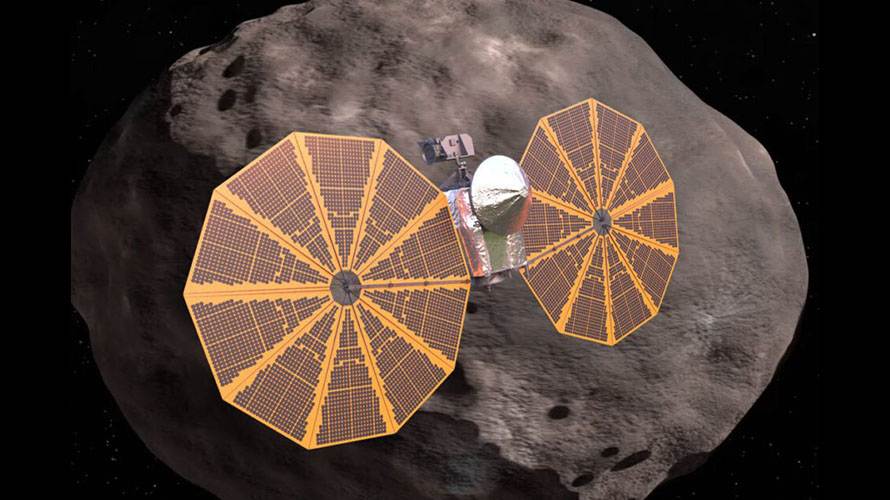
© by Dale Skran, NSS Chief Operating Officer
Image: NASA Lucy mission will fly by eight asteroids (courtesy NASA)
You can’t develop or settle that which is not yet explored, so there is a synergistic relationship between planetary probes, especially missions to the Moon, asteroids, and Mars, and future space development and settlement. Of course, in the longer term the entire solar system is a destination for settlement, but focusing on the Moon, the asteroids, and Mars in 2021 seems appropriate. Let’s review the year by mission target.
The Moon was not a popular destination in 2021. The only notable mission activity was the Chinese “Chang’e 5”, the orbiter component of which was captured by the Sun-Earth L1 point on March 15th, 2021, becoming the first Chinese spacecraft to do so. The purpose of the extended mission appears to be on-going testing of maneuvering capability, since a lunar flyby was conducted on September 9th, 2021.
The main purpose of the “Chang’e 5” mission was the sample return accomplished in 2020, and it was reported in 2021 that initial analysis of those samples showed them to be about 1.96 billion years old. These “young” lunar samples fill an important data gap that will advance lunar research.
2022 promises to be a much more exciting lunar year. Among the more significant missions planned are:
- Artemis 1: Delivers 10 lunar cubesats as a secondary mission to testing the Orion capsule launched by the SLS.
- CAPSTONE: A lunar orbiter that will test positioning technology. This will be the first lunar cubesat, and is being launched by a Rocket Lab Electron rocket.
- Intuitive Machines IM-1: First NASA Commercial Lunar Payload Services (CLPS) mission on the Nova-C lunar lander; lofted via a Falcon 9.
- Korea Pathfinder Luna Orbiter: The first South Korean lunar orbiter focuses on resource mapping and technology demonstration and will be launched on a Falcon 9.
- Chandrayaan-3: A Geosynchronous Satellite Launch Vehicle Mark III (GSLV Mk III) will power India’s second attempt to land on the Moon. The first failed in 2019.
- Hakuto-R Mission 1: ispace Japan is sending a lunar lander technology demonstrator to the Moon on a Falcon 9.
- Emirates Lunar Mission: A lunar rover that will be aboard the above mentioned Hakuto-R Mission 1 lander.
- SLIM (Smart Lander for Investigating Moon): The first Japanese surface mission is focused on demonstrating precision lunar landing technology, and will fly on an H-IIA rocket.
- Mission One: The first NASA CLPS mission using the Astrobotic Technology lander and lofted to the Moon on the Vulcan Centaur.
Incredibly, this is only a partial list of planned 2022 missions. If only half of them succeed, 2022 has the potential to be the busiest year ever for robotic lunar exploration and development.
Unlike the Moon, Mars had a busy 2021. Three major missions launched in 2020 arrived at Mars during 2021, including:
- Emirates Mars Mission/Hope: The orbiter entered Mars orbit February 9th.
- Tianwen-1: This Chinese mission included an orbiter that arrived on February 10th, and a lander that touched down May 14th, disgorging the Zhurong rover, which is currently operational. This first of its kind Chinese mission entered China into an elite club whose members have successfully soft-landed something on Mars.
- Perseverance: The U.S. NASA rover landed on February 18th, and is currently collecting samples for return to Earth via a future mission.
- Ingenuity: A helicopter delivered with Perseverance; it flew on Mars for the first time April 19th.
The Perseverance mission held special importance from a space development perspective. The Ingenuity helicopter—the first powered flight on a planet other than Earth—will surely lead to capabilities that will prove useful in the development and settlement of Mars. Additionally, Perseverance carries MOXIE (Mars Oxygen In-Situ Resource Utilization Experiment), an experiment that will extract oxygen from the Martian atmosphere, making it the first ever demonstration of the potential of ISRU (In-situ Resource Utilization).
Looking ahead to 2022, only two new probes to Mars are in queue:
- Psyche: A U.S. asteroid mission that will fly by Mars in 2023 enroute to a metal rich asteroid.
- ExoMars 2022: A Joint Russian/ESA lander/rover is planned for a launch to Mars. This mission was originally planned for launch in 2020, but was delayed to 2022 due to technical issues.
At one point, Elon Musk was talking about a Starship/Superheavy launch to Mars in the Q3 2022 launch window, but this is now out of reach as the major goal for Starship/Superheavy is to make orbit in 2022. The Q4 2024 Mars window is still a possibility, so stay tuned.
Two important asteroid events occurred in 2021:
- DART: A NASA asteroid redirection test launched November 24th on a Falcon 9. It is planned to encounter the asteroid Dimorphos on September 26, 2022. The target asteroid is part of a binary asteroid system, with the main asteroid being Didymos A. Dimorphos is not an Earth-crossing asteroid and there no possibility that its orbit will be altered by the experiment such that Earth is endangered. DART itself will impact the asteroid in an attempt to alter its orbit.
- Lucy: A NASA mission to the Jupiter Trojan asteroids launched on a 12-year voyage October 16 by an Atlas V. We won’t see much from Lucy in 2022 since it will not encounter its first target, 52246 DonaldJohanson, until April 20, 2025. In addition to this asteroid, Lucy will visit an impressive seven more: 3548 Eurybates (12 August 2027), 15094 Polymele (15 September 2027), 11351 Leucus (18 April 2028), 21900 Orus (11 November 2028), and 617 Patroclus-Menoetius (2 March 2033). The Jupiter Trojans are a high-priority science target in the Decadal Survey. They are old, dark, and cold, and are expected to provide a window into the evolution of the solar system. From a space development perspective, all information about asteroid resources is valuable, and it is possible that the Jupiter Trojans are as numerous as the main belt asteroids, making them a rich source of potential resources.
Another exciting NASA asteroid mission, Psyche, is planned for an August 2022 launch on a Falcon Heavy, with an expected encounter with the metal-rich asteroid Psyche in 2026.
2021 was a great year for asteroid exploration and planetary defense, setting the foundation for an actual asteroid deflection test in 2022 and years of discoveries from the Lucy mission.
In summary, during 2021 robot probes made significant advances that will support space development and settlement, but 2022 looms as even more exciting, especially with regard to lunar and asteroid missions.



















